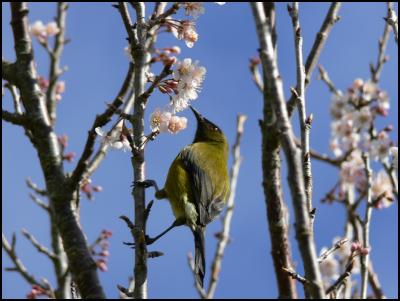Bringing the bellbirds back
Bringing the bellbirds back
Bringing bellbirds back to Hamilton is the aim of an ambitious new reintroduction programme being led by Landcare Research and the University of Waikato.
The bellbird – commonly known in Maori as korimako or makomako – is an endemic native bird not seen in Hamilton for more than a century.
Now a multi-agency programme is to release bellbirds from Auckland’s Tiritiri Matangi and Tawharanui bird sanctuaries into the Hamilton Gardens, with the aim of ultimately building up a breeding population in the city.
Partnering Landcare Research and the university are Environment Waikato (which is helping bring tui back to Hamilton with the Halo project), Hamilton City Council, Nga Mana Toopu o Kirikiriroa, the Department of Conservation, and the Ornithological Society of New Zealand.
Landcare Research’s John Innes said preparatory work for the release has involved pest control at the Hammond Park bush area upstream of the Gardens. “We want to make sure these bellbird have the best possible chance of getting established in our city.” The actual release of the bellbirds is scheduled for Sunday 9 May.
EW’s regional pest management committee chair Simon Friar said: “I am hopeful that this project with bellbirds will build on the good results we’ve been achieving with tui in the city.”
Hamilton councillor Paula Southgate, who has championed Halo since its inception, said support for tui had been popular with the public and it would be great to see bellbirds get re-established in Hamilton.
“Before human arrival the bellbird was found throughout New Zealand but had either disappeared or drastically declined by the mid-late nineteenth century. I hope restoring bellbirds to Hamilton will capture the public’s imagination in the same way that helping tui has.”
When the bellbirds are transferred, supplementary feeders will be used at the Hamilton Gardens to help the birds adjust to their new surroundings. And, for the first time with bellbirds, “acoustic anchoring” will be used at bush sites near the gardens to help stop them flying away from the central city – this involves playing recorded song from the bellbirds’ home dialect for 10 days so they think other bellbirds are around.
To monitor how many are staying around, about 20 birds will have radio transmitters attached, with a two-week battery supply And the Ornithological Society’s Waikato branch has been invited to monitor birds at the feeders in the gardens by recording leg bands.
“We’re also keen to hear of any public sightings of the birds after they are released,” said Mr Innes. “Public reporting of bellbird sightings will give an idea of their distribution throughout the city. This is the only long-term way for the project managers to know how successful the reintroduction has been.”
Cr Southgate agreed the public’s eyes and ears were crucial to the success of the bellbird project. “There were hundreds of tui sightings reported by the public between July last year and the start of this year. That information has helped us get a much better feel for the success of the Halo pest control at tui breeding sites around the city. Now we need to hear about bellbird sightings.”
People will be able to report sightings to http://ew.govt.nz/Projects/Hamilton-Halo/Bellbirds-korimako/.
The release of the bellbirds will be open to media and the public. At this stage, the tentative time and date for the release in the Te Parapara Garden is 8am on Sunday 9 May but this could change depending on a range of factors. Media and members of the public are advised to visit EW’s website www.ew.govt.nz the night before to check for any postponement or cancellation announcement.
Members of the public can keep up to date with latest news and information about Hamilton Halo at www.facebook.com/hamiltonhalo or www.twitter.com/hamiltonhalo.
ENDS



 Gordon Campbell: On Why We Can’t Survive Two More Years Of This
Gordon Campbell: On Why We Can’t Survive Two More Years Of This New Zealand Police: More Than $2.5m Worth Of Assets Restrained In Undeclared Tobacco Case
New Zealand Police: More Than $2.5m Worth Of Assets Restrained In Undeclared Tobacco Case SPCA: Survey Shows Government Lacks Mandate To Repeal Live Export Ban
SPCA: Survey Shows Government Lacks Mandate To Repeal Live Export Ban Peace Action Ōtautahi: Bridge Of Remembrance Peace Protest
Peace Action Ōtautahi: Bridge Of Remembrance Peace Protest National Wetland Trust: Public Asked To Help Prevent Fires In Wetlands This Summer
National Wetland Trust: Public Asked To Help Prevent Fires In Wetlands This Summer Lillian Hanly, RNZ: The Year In Politics - Stories That Dominated The Headlines In 2024
Lillian Hanly, RNZ: The Year In Politics - Stories That Dominated The Headlines In 2024 Waikato Regional Council: Studies Open Door To Mercury Islands Underwater World
Waikato Regional Council: Studies Open Door To Mercury Islands Underwater World


